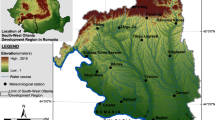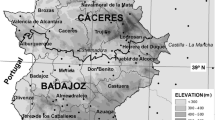Abstract
For investigating aridity in Vojvodina, two parameters were used: the De Martonne aridity index and the Pinna combinative index. These indices were chosen as the most suitable for the analysis of climate in Vojvodina (a region in northern part of Serbia). Also, these indices were calculated from data obtained from 10 meteorological stations for the period from 1949 to 2006. The spatial distribution of the annual and seasonal De Martonne and the Pinna combinative indices as well as the mean monthly values of the De Martonne index and aridity trends of these indices are presented. There were two, four, and five types of climate on a yearly, seasonal, and monthly basis in Vojvodina, according to the De Martonne climate classification which consists of a total of seven types. In addition, semi-humid and humid climate types were represented in the region, on a yearly basis. The winter season was dominated by wetter types of climate, while the summer season was characterized by drier ones. During the spring and autumn seasons, there were types of climate which range between both aforementioned types. Two out of three climate types, which can be identified using the Pinna combinative index, were registered in Vojvodina region. The most dominant climate type was the semidry Mediterranean with formal Mediterranean vegetation, while the humid type was only identified in one small part of southwestern Vojvodina. The calculated values of both aridity indices showed that there were no annual trends. Therefore, it can be considered that there were no recent aridity changes during the observed period. For paleoclimate, the general story is more complex. The lack of aridity trends in the recent period from 1949 to 2006 supports the fact that Vojvodina has very well preserved loess–palaeosol sequences from the Middle and Late Pleistocene, which indicates that crucial point for their preservation was caused by the weak aridity variability in the region.







Similar content being viewed by others
References
Adnan S, Haider S (2012) Classification and assessment of aridity in Pakistan by using different aridity indices ftp://ftp.wmo.int/Documents/PublicWeb/arep/Weather_Mod_Bali/ENV%20bruntjes.chalon/ENV.Adnan_Pakistan_paper1.pdf. Accessed 21 November 2012
Alexandersson H (1986) A homogeneity test applied to precipitation data. J Climatol 6:661–675
Arora VK (2002) The use of the aridity index to assess climate change effect on annual runoff. J Hydrol 265(1–4):164–177
Baltas E (2007) Spatial distribution of climatic indices in northern Greece. Meteorol Appl 14:69–78
Baltas E (2010) Surface representation of climatic variables and indices in Greece using GIS methods. Int J Meteorol 35(348):123–136
Baltas E, Mimikou M (2005) Climate change impacts on the water supply of Thessaloniki. Int J Water Resour Dev 21(2):341–353
Burrough PA (1986) Principles of geographical information systems for land resources assessment. Clarendon, Oxford
Collins FC, Bolstad PV (1996) A comparison of spatial interpolation techniques in temperature estimation. Proceedings of the Third International Conference/Workshop on Integrating GIS and Environmental Modeling, Santa Fe, New Mexico, January 21–25, 1996. Santa Barbara, California: National Center for Geographic Information Analysis (NCGIA)
Cook ER, Woodhouse CA, Mark EC, Meko DM, Stahle DW (2004) Long-term aridity changes in the western United States. Science 306(5698):1015–1018
Coscarelli R, Gaudio R, Caloiero T (2004) Climatic trends: an investigation for a Calabrian basin (southern Italy), the basis of civilization-water science? Proceedings of the UNESCO/IAHS/1WHA Symposium, Rome, December 2003. 1 AI1S Publ 286: 255–266
Croitoru АЕ, Piticar А, Imbroane АМ, Burada DC (2012) Spatiotemporal distribution of aridity indices based on temperature and precipitation in the extra-Carpathian regions of Romania. Theor Appl Climatol. doi:10.1007/s00704-012-0755-2
CRU (2003) Global average temperature change 1856–2003. http://www.cru.uea.ac.uk/cru/data/temperature/. Accessed 6 Mar 2012
De Martonne E (1925) Traité de Géographie Physique, Vol I: Notions generales, climat, hydrographie. Geogr Rev 15(2):336–337
Deniz A, Toros H, Incecik S (2011) Spatial variations of climate indices in Turkey. Int J Climatol 3:394–403
Emberger E (1932) Sur une formule climatique et ses applications en botanique. La Météorologie 423–432
Franke R (1982) Scattered data interpolation: tests of some methods. Math Comput 38:181–200
Franke R, Nielson G (1991) Scattered data interpolation and applications: a tutorial and survey. In: Hagen H, Roller D (eds) Geometric modelling: methods and applications. Springer, Berlin, pp 131–160
Gavrilov MB, Lazić L, Pešić A, Milutinović M, Marković D, Stanković A, Gavrilov MM (2010) Influence of hail suppression on the hail trend in Serbia. Phys Geogr 31(5):441–454
Gavrilov MB, Lazić L, Milutinović M, Gavrilov MM (2011) Influence of hail suppression on the hail trend in Vojvodina, Serbia. Geographica Pannonica 15(2):36–41
Gilbert RO (1987) Statistical methods for environmental pollution monitoring. Van Nostrand Reinhold, New York
Hatte C, Gauthier C, Rousseau DD, Antoine P, Fuchs M, Lagroix F, Marković SB, Moinne O, Sima A (2013) Excursions to C4 vegetation recorded in the Upper Pleistocene loess of Surduk (Northern Serbia): an organic isotope geochemistry study. Clim Past Discuss 9: 187–215
Hrnjak I, Lukić T, Gavrilov MB, Marković SB (2012) Recent aridization trends as a possible link for understanding the mechanism for the formation of loess deposits in Vojvodina region (N Serbia). Proceedings of the “ED@80: Loess in China and Europe—a Tribute to Edward Derbyshire,” Novi Sad, September 2012. Abstract book: 79–80
Hulme M, Barrow EM, Arnell NW, Harrisson PA, Johns TC, Downing TE (1999) Relative impacts of human-induced climate change and natural climate variability. Nature 397:688–691
Hutchinson MF, Gessler PT (1994) Splines—more than just a smooth interpolator. Geodema 62:45–67
IPCC (2007) Climate change 2007: mitigation. Contribution of Working Group III to the fourth assessment report of the Intergovernmental Panel on Climate Change. Cambridge University Press, Cambridge
Johnston K, Ver Hoef JM, Krivoruchko K, Lucas N (2001) Using ArcGIS geostatistical analyst. ESRI, Redlands
Kendall M (1938) A new measure of rank correlation. Biometrika 30:81–89
Kendall MG (1975) Rank correlation methods, 4th edn. Charles Griffin, London
Kenny GJ, Ye W, Flux T, Warrick RA (2001) Climate variations and New Zealand agriculture: the CLIMPACTS system and issues of spatial and temporal scale. Environ Int 27:189–194
Lam NS (1983) Spatial interpolation methods: a review. The American Cartographer 10:129–149
Lukić T, Marković SB, Stevens T, Vasiljević DjA, Machalett B, Milojković N, Basarin B, Obreht I (2009) The loess cave near the village of Surduk—an unusual pseudokarst landform in the loess of Vojvodina, Serbia. Acta Carsologica 38(2–3):227–235
Mann HB (1945) Non-parametric tests against trend. Econometrica 13:245–259
Marković SB, Oches E, Sümegi P, Jovanović M, Gaudenyi T (2006) An introduction to the Upper and Middle Pleistocene loess-paleosol sequences of Ruma section (Vojvodina, Serbia). Quat Int 149:80–86
Marković SB, Oches EA, McCoy WD, Gaudenyi T, Frechen M (2007) Malacological and sedimentological evidence for “warm” climate from the Irig loess sequence (Vojvodina, Serbia). Geophysics, Geochemistry and Geosystems 8, Q09008. doi:10.1029/2006GC001565
Marković SB, Bokhorst M, Vandenberghe J, Oches EA, Zöller L, McCoy WD, Gaudenyi T, Jovanović M, Hambach U, Machalett B (2008) Late Pleistocene loess-paleosol sequences in the Vojvodina region, North Serbia. J Quat Sci 23:73–84
Marković SB, Hambach U, Catto N, Jovanović M, Buggle B, Machalett B, Zöller L, Glaser B, Frechen M (2009) The middle and late Pleistocene loess-paleosol sequences at Batajanica, Vojvodina, Serbia. Quat Int 198:255–266
Marković SB, Hambach U, Stevens T, Kukla GJ, Heller F, William D, McCoy WD, Oches EA, Buggle B, Zöller L (2011) The last million years recorded at the Stari Slankamen loess-palaeosol sequence: revised chronostratigraphy and long-term environmental trends. Quat Sci Rev 30:1142–1154
Marković SB, Hambach U, Stevens T, Basarin B, O’Hara-Dhand K, Gavrilov MM, Gavrilov MB, Smalley I, Teofanov N (2012a) Relating the astronomical timescale to the loess–paleosol sequences in Vojvodina, Northern Serbia. In: Berger A et al (eds) Climate change, part 2. Springer, Vienna, pp 65–78. doi:10.1007/987-3-7091-0973-1
Marković SB, Hambach U, Jovanović M, Stevens T, O’Hara-Dhand K, Basarin B, Smalley I, Buggle B, Zech M, Milojković N, Zöller L (2012b) Loess in Vojvodina region (Northern Serbia): the missing link between European and Asian Pleistocene environments. Neth J Geosci 91:173–188
McCullagh MJ (1988) Terrain and surface modelling systems: theory and practice. Photogramm Rec 12:747–779
Palmer W (1965) Meteorological drought. U.S. Department of Commerce Weather Bureau, Washington
Petrović MD, Vasiljević DjA, Vujičić MD, Hose TA, Marković SB, Lukić T (2013) Global geopark and candidate—comparative analysis of Papuk Mountain Geopark (Croatia) and Fruška Gora Mountain (Serbia) by using GAM model. Carpathian J Earth Environ Sci 8(1):105–116
Shahid S (2008) Spatial and temporal characteristics of droughts in the western part of Bangladesh. Hydrol Process 22:2235–2247
Shahid S (2010) Spatio-temporal variation of aridity and dry period in term of irrigation demand in Bangladesh. Am-Eurasia J Agric Environ Sci 7(4):386–396
Sharp J (2010) Microsoft Visual C# 2010 step by step. Microsoft Press, Redmond, WA
Thornthwaite CW (1948) An approach toward a rational classification of climate. Geogr Rev 38(1):55–94
Vasiljević DjA, Marković SB, Hose TA, Smalley I, O'Hara Dhand K, Basarin B, Lukić T, Vujičić MD (2011) Loess towards (geo) tourism-proposed application on loess in Vojvodina region (north Serbia). Acta Geographica Slovenica 51: 391–406
Vujičić MD, Vasiljević DjA, Marković SB, Hose TA, Lukić T, Hadžić O, Janićević S (2011) Preliminary geosite assessment model (GAM) and its application on Fruška Gora Mountain, potential geotourism destination of Serbia. Acta Geographica Slovenica 51:361–376
Watson DF, Philip GM (1987) Neighbourhood based interpolation. Geobyte 2:12–16
Wu S, Yin Y, Zheng D, Yang Q (2006) Moisture conditions and climate trends in China during the period 1971–2000. Int J Climatol 26:193–206
Zambakas J (1992) General climatology. Department of Geology, National & Kapodistrian University of Athens, Athens
Zarghami M, Abdi A, Babaeian I, Hassanzadeh Y, Kanani R (2011) Impacts of climate change on runoffs in East Azerbaijan, Iran. Global Planet Change 78(3–4):137–146
Zhao D, Zheng D, Wu S, Wu Z (2007) Climate changes in northeastern China during last four decades. Chin Geogr Sci 17(4):317–324
Acknowledgments
This research paper was supported by Projects 176020 and 176013 of the Serbian Ministry of Education and Science. The authors are grateful to Mr. Momčilo M. Gavrilov for the support. The authors appreciate the suggestions of reviewers that led to an improvement of the paper.
Author information
Authors and Affiliations
Corresponding author
Rights and permissions
About this article
Cite this article
Hrnjak, I., Lukić, T., Gavrilov, M.B. et al. Aridity in Vojvodina, Serbia. Theor Appl Climatol 115, 323–332 (2014). https://doi.org/10.1007/s00704-013-0893-1
Received:
Accepted:
Published:
Issue Date:
DOI: https://doi.org/10.1007/s00704-013-0893-1




